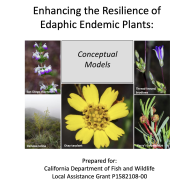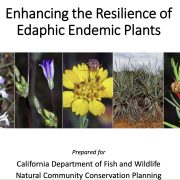CBI is working to enhance the resilience of five edaphic endemic plants in San Diego County: Acanthomintha ilicifolia, Brodiaea filifolia, Deinandra conjugens, Nolina interrata, and Tetracoccus dioicus
Southern California NCCPs support edaphic endemic plants that face low genetic diversity due to reduced population sizes, geographic isolation, and loss of pollinators. To enhance the resilience of these species across their ranges, we must manage threats to increase population sizes, identify potentially suitable habitat to connect existing populations, find or restore new populations, and provide opportunities for shifting distributions due to climate change. The Management Strategic Plan for San Diego County requires prioritization and management for edaphic endemic plants, including the five species addressed in this proposal: Acanthomintha ilicifolia, Brodiaea filifolia, Deinandra conjugens, Nolina interrata, and Tetracoccus dioicus. Regional goals include maintaining or expanding existing occurrences or establishing new occurrences to increase resilience to environmental stochasticity, maintaining genetic diversity, and ensuring persistence over the long-term in native plant communities.
This study presents an approach for identifying and describing geographic areas that support edaphic endemic species and their habitat in a design that enhances resilience and provides opportunities for shifting distributions. We developed conceptual models to inform field studies and management, refined soils and vegetation attributes, and assessed regional population structure and threats. We used results to suggest prioritized locations for surveys, management, potential translocation, and additional conservation or acquisition. Project partners (U.S. Geological Survey and San Diego Management and Monitoring Program) modeled suitable habitat for the target species under current and future climate scenarios; we reference models as appropriate.
All target species occur on nutrient poor soils, and each species is associated with a unique suite of physical and chemical soil properties. We provide a range of variables for each species that can inform site selection for management and restoration. Testing soil before enhancing or augmenting small occurrences will allow us to locate suitable sites and eliminate or remediate unsuitable sites with remnant populations before investing management funds.
We used distribution data, habitat suitability models, genetic principles and information to develop regional population structures for each target species. We then identified populations or population groups important for long-term resilience and locations where conservation and management actions would be most beneficial.
Models predict declining habitat in the future for all target species under various climate scenarios, although the amount of predicted habitat remaining varies among species. We recommend conserving future predicted suitable habitat within or beyond San Diego County, and experimentally translocating target species into this habitat as climatic conditions change if monitoring indicates further species declines.
This work contributes to San Diego NCCP subarea plans in progress and other NCCPs. The project area includes the North County MSCP, South County MSCP, and MHCP.
CBI biologists Patricia Gordon-Reedy, Spring Strahm, and Jessie Vinje worked with the San Diego Management and Monitoring Program, U.S. Fish and Wildlife Service, California Department of Fish and Wildlife, The Nature Conservancy, Space and Naval Warfare Systems Command (SPAWAR), and San Diego County land managers on this project. The California Department of Fish and Wildlife funded this work under a Local Assistance Grant.





